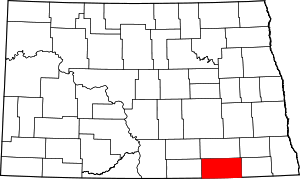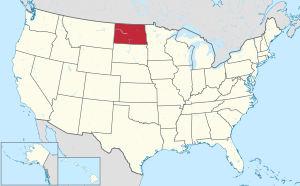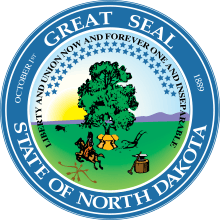Dickey County, North Dakota
Dickey County is a county in the U.S. state of North Dakota. As of the 2010 United States Census, the population was 5,289.[1] Its county seat is Ellendale.[2]
Dickey County | |
|---|---|
.jpg) Postcard. Dickey County Courthouse in 1915. | |
 Location within the U.S. state of North Dakota | |
 North Dakota's location within the U.S. | |
| Coordinates: 46°07′N 98°29′W | |
| Country | |
| State | |
| Founded | March 5, 1881 (created) August 18, 1882 (organized) |
| Named for | George H. Dickey |
| Seat | Ellendale |
| Largest city | Oakes |
| Area | |
| • Total | 1,142 sq mi (2,960 km2) |
| • Land | 1,131 sq mi (2,930 km2) |
| • Water | 11 sq mi (30 km2) 0.9% |
| Population (2010) | |
| • Total | 5,289 |
| • Estimate (2019) | 4,872 |
| • Density | 4.6/sq mi (1.8/km2) |
| Time zone | UTC−6 (Central) |
| • Summer (DST) | UTC−5 (CDT) |
| Congressional district | At-large |
| Website | www |
History
The Dakota Territory legislature created Dickey County on March 5, 1881, with territories annexed from McPherson County, South Dakota and Ransom County, North Dakota, with some previously unorganized territories added. Its governing structure was effected on August 18, 1882. It was named for a member of the Territorial Legislature, George H. Dickey.[3][4][5]
Geography
Dickey County lies on the south side of North Dakota. Its south boundary line abuts the north boundary line of the state of South Dakota. The James River flows south-southeasterly through the east part of the county, and the Maple River flows south-southwesterly through the center part of the county. The county terrain consists of rolling hills, dotted with lakes and ponds in its western portion, with the area devoted to agriculture.[6] The terrain slopes to the south and east, with its highest point being a hill near the SW corner at 2,139' (652m) ASL.[7] The county has a total area of 1,142 square miles (2,960 km2), of which 1,131 square miles (2,930 km2) is land and 11 square miles (28 km2) (0.9%) is water.[8]
Major highways




Adjacent counties
- LaMoure County - north
- Ransom County - northeast
- Sargent County - east
- Brown County, South Dakota - south
- McPherson County, South Dakota - southwest
- McIntosh County - west
National protected areas
Lakes[6]
- Hilles Lake
- Pheasant Lake
Demographics
| Historical population | |||
|---|---|---|---|
| Census | Pop. | %± | |
| 1890 | 5,573 | — | |
| 1900 | 6,061 | 8.8% | |
| 1910 | 9,839 | 62.3% | |
| 1920 | 10,499 | 6.7% | |
| 1930 | 10,877 | 3.6% | |
| 1940 | 9,696 | −10.9% | |
| 1950 | 9,121 | −5.9% | |
| 1960 | 8,147 | −10.7% | |
| 1970 | 6,976 | −14.4% | |
| 1980 | 7,207 | 3.3% | |
| 1990 | 6,107 | −15.3% | |
| 2000 | 5,757 | −5.7% | |
| 2010 | 5,289 | −8.1% | |
| Est. 2019 | 4,872 | [9] | −7.9% |
| US Decennial Census[10] 1790-1960[11] 1900-1990[12] 1990-2000[13] 2010-2019[1] | |||
2000 census
As of the 2000 United States Census, there were 5,757 people, 2,283 households, and 1,499 families in the county. The population density was 5 people per square mile (2/km²). There were 2,656 housing units at an average density of 2 per square mile (1/km²). The racial makeup of the county was 97.78% White, 0.10% Black or African American, 0.35% Native American, 0.50% Asian, 0.56% from other races, and 0.71% from two or more races. 1.35% of the population were Hispanic or Latino of any race. 48.9% were of German, 14.7% Norwegian, 6.7% American and 6.0% Irish ancestry. 92.3% spoke English, 5.7% German and 1.5% Spanish as their first language.
There were 2,283 households out of which 27.90% had children under the age of 18 living with them, 58.00% were married couples living together, 4.90% had a female householder with no husband present, and 34.30% were non-families. 32.00% of all households were made up of individuals and 17.60% had someone living alone who was 65 years of age or older. The average household size was 2.36 and the average family size was 2.99.
The county population contained 23.80% under the age of 18, 10.20% from 18 to 24, 22.50% from 25 to 44, 22.20% from 45 to 64, and 21.30% who were 65 years of age or older. The median age was 41 years. For every 100 females there were 97.20 males. For every 100 females age 18 and over, there were 92.50 males.
The median income for a household in the county was $29,231, and the median income for a family was $36,682. Males had a median income of $26,914 versus $15,668 for females. The per capita income for the county was $15,846. About 11.60% of families and 14.80% of the population were below the poverty line, including 20.40% of those under age 18 and 10.80% of those age 65 or over.
2010 census
As of the 2010 United States Census, there were 5,289 people, 2,180 households, and 1,379 families in the county.[14] The population density was 4.7 inhabitants per square mile (1.8/km2). There were 2,636 housing units at an average density of 2.3 per square mile (0.89/km2).[15] The racial makeup of the county was 96.5% white, 0.7% black or African American, 0.6% American Indian, 0.4% Asian, 0.5% from other races, and 1.2% from two or more races. Those of Hispanic or Latino origin made up 1.9% of the population.[14] In terms of ancestry, 56.3% were German, 16.9% were Norwegian, 11.4% were Irish, 7.4% were Swedish, 5.1% were Russian, and 1.1% were American.[16]
Of the 2,180 households, 26.5% had children under the age of 18 living with them, 56.0% were married couples living together, 4.4% had a female householder with no husband present, 36.7% were non-families, and 33.3% of all households were made up of individuals. The average household size was 2.29 and the average family size was 2.94. The median age was 43.0 years.[14]
The median income for a household in the county was $37,179 and the median income for a family was $53,333. Males had a median income of $36,029 versus $25,625 for females. The per capita income for the county was $21,824. About 6.8% of families and 11.0% of the population were below the poverty line, including 9.3% of those under age 18 and 18.2% of those age 65 or over.[17]
Communities
Politics
Dickey County voters are traditionally Republican-leaning. In only one national election since 1936 has the county selected the Democratic Party candidate (as of 2016).
| Year | Republican | Democratic | Third parties |
|---|---|---|---|
| 2016 | 69.3% 1,667 | 23.0% 554 | 7.7% 186 |
| 2012 | 63.5% 1,610 | 33.7% 853 | 2.8% 72 |
| 2008 | 58.2% 1,525 | 39.9% 1,044 | 2.0% 51 |
| 2004 | 67.0% 1,890 | 31.3% 883 | 1.7% 48 |
| 2000 | 66.5% 1,853 | 28.9% 806 | 4.6% 127 |
| 1996 | 53.2% 1,418 | 35.8% 953 | 11.0% 294 |
| 1992 | 49.5% 1,514 | 30.0% 918 | 20.5% 628 |
| 1988 | 61.9% 2,064 | 37.4% 1,249 | 0.7% 23 |
| 1984 | 69.4% 2,460 | 29.6% 1,051 | 1.0% 35 |
| 1980 | 68.7% 2,455 | 25.7% 917 | 5.7% 202 |
| 1976 | 54.7% 2,027 | 43.5% 1,612 | 1.9% 70 |
| 1972 | 63.6% 2,277 | 35.4% 1,266 | 1.1% 38 |
| 1968 | 62.3% 2,087 | 32.8% 1,098 | 4.9% 163 |
| 1964 | 49.8% 1,808 | 50.1% 1,818 | 0.1% 4 |
| 1960 | 62.8% 2,420 | 37.2% 1,433 | 0.1% 3 |
| 1956 | 61.7% 2,327 | 38.1% 1,435 | 0.2% 8 |
| 1952 | 71.2% 2,917 | 28.1% 1,150 | 0.7% 28 |
| 1948 | 54.9% 1,774 | 39.1% 1,264 | 6.0% 194 |
| 1944 | 61.1% 2,134 | 38.3% 1,339 | 0.5% 19 |
| 1940 | 57.4% 2,777 | 35.6% 1,721 | 7.0% 337 |
| 1936 | 34.4% 1,533 | 51.3% 2,287 | 14.3% 638 |
| 1932 | 30.7% 1,424 | 66.1% 3,068 | 3.3% 151 |
| 1928 | 52.9% 2,250 | 46.5% 1,977 | 0.6% 26 |
| 1924 | 43.7% 1,716 | 9.0% 352 | 47.4% 1,862 |
| 1920 | 75.8% 2,887 | 20.1% 766 | 4.1% 156 |
| 1916 | 50.1% 1,037 | 44.5% 920 | 5.4% 112 |
| 1912 | 29.9% 494 | 43.8% 723 | 26.3% 435 |
| 1908 | 61.0% 1,062 | 36.3% 633 | 2.7% 47 |
| 1904 | 69.6% 998 | 23.5% 336 | 6.9% 99 |
| 1900 | 56.2% 763 | 41.8% 567 | 2.1% 28 |
References
- "State & County QuickFacts". United States Census Bureau. Archived from the original on June 7, 2011. Retrieved October 31, 2013.
- "Find a County". National Association of Counties. Archived from the original on May 31, 2011. Retrieved June 7, 2011.
- Gannett, Henry (1905). The Origin of Certain Place Names in the United States. Govt. Print. Off. p. 106.
- "Dakota Territory, South Dakota, and North Dakota: Individual County Chronologies". Dakota Territory Atlas of Historical County Boundaries. The Newberry Library. 2006. Retrieved February 3, 2015.
- "County History". North Dakota.gov. The State of North Dakota. Archived from the original on February 2, 2015. Retrieved February 3, 2015.
- Dickey County ND Google Maps (accessed 17 February 2019)
- ""Find an Altitude/Dickey County ND" Google Maps (accessed 17 February 2019)". Archived from the original on May 21, 2019. Retrieved February 17, 2019.
- "2010 Census Gazetteer Files". US Census Bureau. August 22, 2012. Archived from the original on January 29, 2015. Retrieved January 28, 2015.
- "Population and Housing Unit Estimates". Retrieved April 2, 2020.
- "US Decennial Census". US Census Bureau. Retrieved January 28, 2015.
- "Historical Census Browser". University of Virginia Library. Retrieved January 28, 2015.
- Forstall, Richard L., ed. (March 27, 1995). "Population of Counties by Decennial Census: 1900 to 1990". US Census Bureau. Retrieved January 28, 2015.
- "Census 2000 PHC-T-4. Ranking Tables for Counties: 1990 and 2000" (PDF). US Census Bureau. April 2, 2001. Retrieved January 28, 2015.
- "Profile of General Population and Housing Characteristics: 2010 Demographic Profile Data". US Census Bureau. Archived from the original on February 13, 2020. Retrieved March 14, 2016.
- "Population, Housing Units, Area, and Density: 2010 - County". US Census Bureau. Archived from the original on February 13, 2020. Retrieved March 14, 2016.
- "Selected Social Characteristics in the US – 2006-2010 American Community Survey 5-Year Estimates". US Census Bureau. Archived from the original on February 13, 2020. Retrieved March 14, 2016.
- "Selected Economic Characteristics – 2006-2010 American Community Survey 5-Year Estimates". US Census Bureau. Archived from the original on February 13, 2020. Retrieved March 14, 2016.
- Leip, David. "Atlas of US Presidential Elections". uselectionatlas.org. Retrieved April 12, 2018.
External links
- Dickey County map, North Dakota DOT
